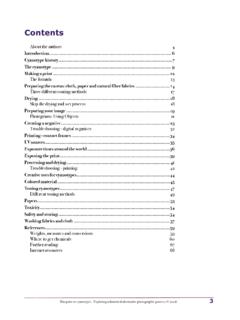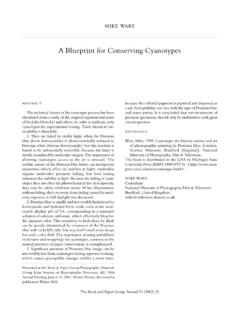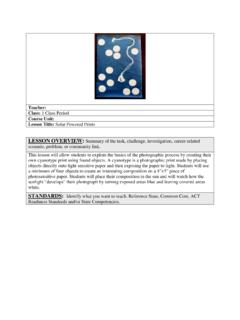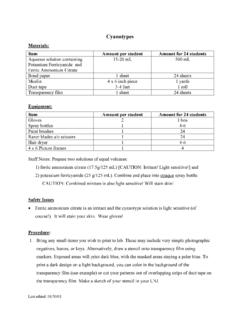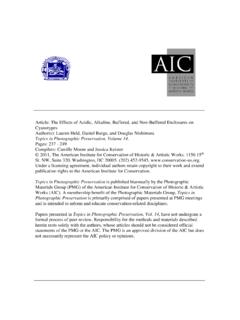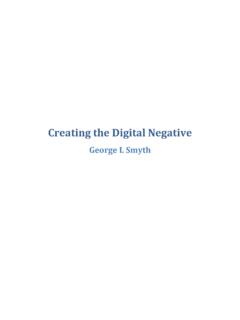Transcription of Cyanotype - AlternativePhotography.com
1 Cyanotype A workshop for beginners using pre coated papersCyanotypes 2011 You are free: to Share to copy, distribute and transmit the workUnder the following conditions: Attribution You must attribute the work in the manner specified by the author or licensor (but not in any way that suggests that they endorse you or your use of the work). Noncommercial You may not use this work for commercial purposes. No Derivative Works You may not alter, transform, or build upon this the understanding that: Waiver Any of the above conditions can be waived if you get permission from the copyright holder. Public Domain Where the work or any of its elements is in the public domain under applicable law, that status is in no way affected by the license.
2 Other Rights In no way are any of the following rights affected by the license: Your fair dealing or fair use rights, or other applicable copyright exceptions and limitations; The author s moral rights; Rights other persons may have either in the work itself or in how the work is used, such as publicity or privacy rights. Notice For any reuse or distribution, you must make clear to others the license terms of this 2011byMalin Fabbri 10113 42 StockholmSwedenCopyright 2011 Malin : No ISBNTo download this pdf again, go to: 2011 Notes:Cyanotypes 2011 Cyanotype - one of the first attempts at inventing photographysomething that worked.
3 Some techniques were too slow, so the people being photographed got tired of waiting, some were too expensive, so people could not afford being photographed and some were even poisonous, so the photographer got , John discovered cyanotypes. It was a way of making pictures that was cheap, simple and safe. He discovered that you could brush iron compounds on a paper and get a surface sensitive to light and make a photograph. The only thing that was a bit odd with the photographs was that they turned were not often allowed to invent stuff at that time, their job was to cook, take care of the kids, wash clothes and work. But, a friend of Johns, called Anna Atkins, was a botanist and she used John s cyanotypes to make a book.
4 As a botanist Do you own a camera? Do you like taking pictures? Using cyanotypes pictures were made before most people knew the camera was long, long time ago, people did not own cameras. No holiday pictures and no photographs of mum and dad. Cameras and photography was not yet the year 1842, that is 170 years ago, before your grandmother s grandmother s grandmother s mother lived there was a man called Sir John Herschel. Sir means that he was knighted. He was therefore a very fine English was one of the men trying to invent photography. They tried many different things, but it took a long time before they found This is Herschel photographed by Julia Margaret Cameron.
5 Julia made four portraits of John at his home in Collingwood, in Kent in England. Victoria and Albert Museum, 2011 she documented plants and instead of drawing all the plants, she used cyanotypes to make a picture of what the plant looked like. She made a couple of books, all by hand, and when she did that she was the first person in the world to make a book using photographs. That was in cyanotypes had been used for a while, people invented other ways to take pictures, for example black and white pictures. A lot of people liked black and white better than blue and white, and cyanotypes were nearly forgotten. Today you have even better ways to make photographs with digital cameras that are both faster and easier.
6 Today cyanotypes are used mostly for making art, or experiment with making pictures. Whatever reason you have to want to explore photography and different techniques, the Cyanotype is a creative, relatively safe and exciting process to start Atkins laid plants on Cyanotype paper to photograph them instead of drawing them. This is the book cover of her book British and Foreign Flowering Plants and Ferns .Victoria and Albert Museum, is a picture from Anna Atkins book. Papaver Orientale; which is Poppy, from Cyanotypes of British and Foreign Flowering Plants and Ferns . Victoria and Albert Museum, 2011 Make a pictureIn this workshop the paper is already prepared.
7 We have taken two iron compounds called Potassium ferricyanide and Ferric ammonium citrate (the green variety) and mixed them with water and then brushed them onto the paper. Sir John Herschel s original recipe is still used. Today we will print on paper, but you can also print on all sort of natural material like paper, or cloth made of 100% cotton, linen or paper has then been paper is light sensitive, but just to UV light. UV light exists in the rays of the sun, but also in some lights like those in a sun bed. The paper works like your skin does when you are out in the sun. If you go outside in the sun, you get tanned, even if it takes quite a while.
8 When you put the paper outside in the sunlight it will also change its color. Because of this, you can make your design indoors in ordinary light, without the picture getting photogram is when you place objects directly onto the paper and let the rays from the sun make shades and shapes. In the workshop we will be using this method to make a can make picture with anything: feathers, cutlery, pearls, lace or anything else that can make an interesting shadow or shape. Photograms are like silhouettes, or shadows the objects leave on the can also make pictures using negatives. You will then need quite a large negative, printed out on transparency film.
9 The picture will then be more like a photograph, but blue. Do this:1. Remove a paper from the black bag. The black bag will not let light though and will protect the papers. Close the bag carefully, and squeeze the air out of the bag, to make the papers last longer. Stay away from the windows when you make your design, because the paper will change color in the sun. Ordinary lights are fine to work Put the paper on a piece of sturdy cardboard or Start designing your picture. Put different objects on the paper and shape the design like you want 2011 4. Once you are done with your design, take a piece of cling film and wrap it around the composition, so the object won t move.
10 If your design is made of paper shapes, a negative or very flat objects, it can be easier to use a sheet of glass to hold the shapes in Take the composition out in the the pictureYou will place the picture in the sun for around 20 minutes. If it s cloudy or rainy you can use a UV light instead if you have one. If you are using silk the exposure time is a bit shorter, about 10 minutes and cotton can be longer, around 30 the composition is in the sun, the paper will turn dark green. On the picture below you can see that the chemicals on the t-shirt and the paper have different color. The t-shirt has been in the sun long enough to get exposed and is done.
